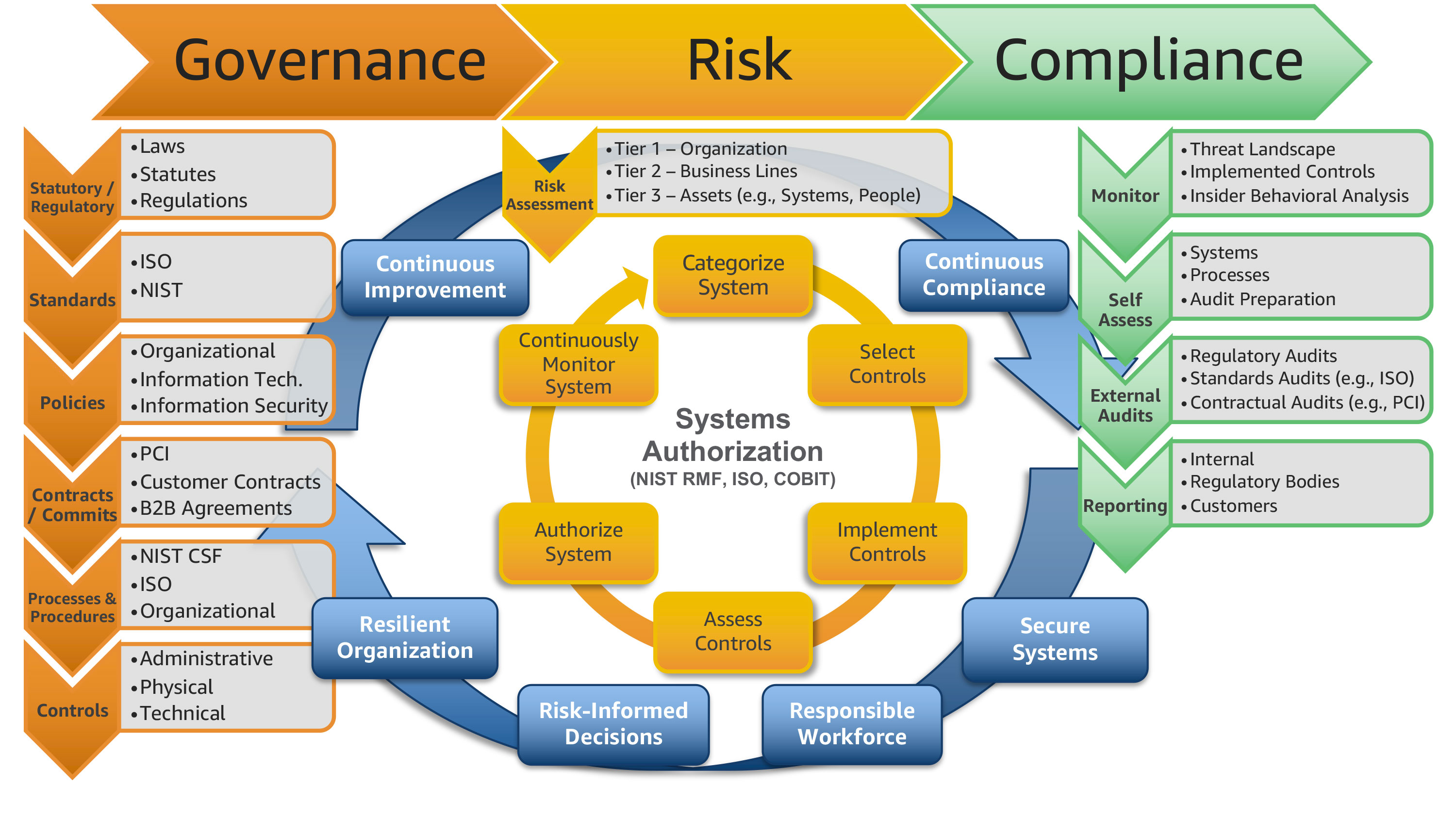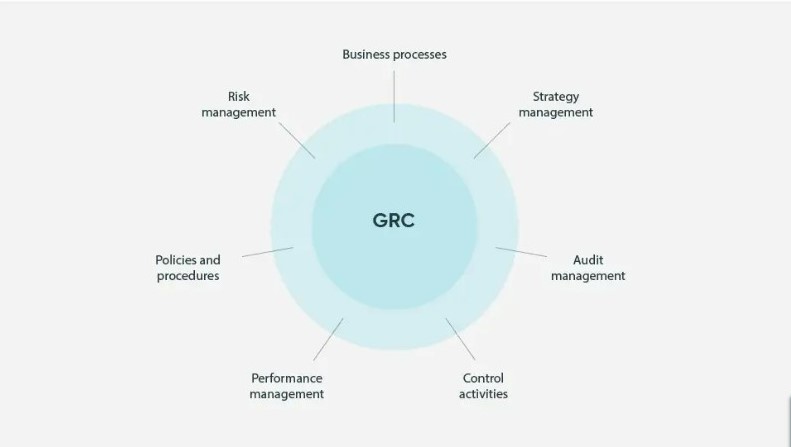- info@techzology.com
- Bahrain, US, UK,EU
Techzology delivers a full range of top-tier cybersecurity services and solutions to strengthen your business with operational resilience, flawless data privacy, and robust protection against cyber threats.
Governance, risk, and compliance (GRC) provide organizations the confidence and tools they need to operate their businesses without overstepping regulatory bounds. Too many organizations lack well-defined GRC programs or have the tendency to neglect funding them. To succeed, organizations must improve resilience and prepare for disruption to remain relevant and deliver value.
The business case for GRC must focus on improving risk visibility, aligning GRC efforts to business priorities, and delivering forward-looking insights to help firms act quickly and decisively.
Governance: The frameworks of an organization’s activities and whether or not they are aligned with business objectives. Activities include processes, structures, and policies that are meant to manage and monitor company activities.
Risk: A sustained process of addressing risks, mitigating risks through controls, and providing assurance that the risks are managed according to policies. This includes measurement of risk, assessment, retention, monitoring, and identification.
Compliance: Ensuring that activities within an organization operate in a way that are aligned with laws and regulations.

Neque porro quisquam est, qui dolorem ipsum quia dolor sit amet, consectetur, adipisci velit, sed quia non numquam eius modi tempora incidunt ut labore et dolore magnam aliquam quaerat voluptatem. Ut enim ad minima veniam, quis nostrum exercitationem ullam corporis suscipit laboriosam, nisi ut aliquid ex ea commodi consequatur.

Effective GRC must:

Effective GRC establishes an approach to ensure that the proper people get the necessary information when it is needed, objectives are established, and the right controls are put into place to address uncertain situations and act.
A GRC process done right yields the following benefits:
Domains where risk and compliance are necessary

| SaaS-enabled? | Mobile app? | 24/7 live support? | Free trial? | Demo? | Recognized by Forrester? | Recognized by Gartner? | |
|---|---|---|---|---|---|---|---|
| RSA Archer | Yes | Yes | No | No | Yes | Yes | Yes |
| Logic Manager | Yes | No | No | No | Yes | Yes | Yes |
| Riskonnect | Yes | No | No | No | Yes | Yes | Yes |
| SAP | Yes | Yes | No | Yes | No | Yes | No |
| SAI360 | Yes | Yes | No | No | Yes | Yes | Yes |
| MetricStream | Yes | Yes | No | No | Yes | Yes | Yes |
| Enablon | Yes | Yes | Yes | No | Yes | Yes | No |
| ServiceNow | Yes | Yes | Yes | No | Yes | Yes | Yes |
| Fusion Framework | Yes | Yes | No | Yes | No | No | No |

Whether you have a small business or a large enterprise, governance, risk management, and compliance will play some role in your business operations and preparedness. As Benjamin Franklin once said, “If you fail to plan, you plan to fail,” and GRC strategies will thus help your business avoid failure. This happens through planning for organizational structure, vulnerability monitoring and response, and reporting requirements.
Governance describes the top-down approach to managing your organization. Your business’s governance strategy is composed of all the business processes and policies that are structured, implemented, and maintained to preserve productive relationships among all stakeholders. It creates a framework that enables your business operations to run like a well-oiled machine. It also ensures that the top officials are receiving the most accurate information needed to make decisions quickly and effectively.
Risk management refers to the measures put in place to prevent, detect, and respond to vulnerabilities that can impact your organization from all perspectives. Specifically, risk management monitors all departments – most importantly IT, finance, and HR – to ensure your broader business goals won’t be impeded or compromised.
It considers all internal risks as well as those presented by working with third-party vendors. In addition to addressing the risks themselves, risk management also involves mitigating any consequences or potential impact on your organization’s infrastructure, resources, and stakeholders.
Risk management refers to the measures put in place to prevent, detect, and respond to vulnerabilities that can impact your organization from all perspectives. Specifically, risk management monitors all departments – most importantly IT, finance, and HR – to ensure your broader business goals won’t be impeded or compromised.
Compliance involves your business’s ability to fulfill the obligations set forth by government regulations. It relies heavily on documenting all efforts to meet relevant standards, usually concerning data protection and privacy. Some such regulations include the EU’s General Data Protection Regulation (GDPR), the CAN-SPAM Act, the California Consumer Privacy Act (CCPA), and the Health Insurance Portability and Accountability Act (HIPAA).
Overall, a GRC strategy helps make sure every action, resource, and stakeholder is aligned with the business’s broader company objectives.

While finance, healthcare, and manufacturing are probably the first industries to come to mind when you hear risk and compliance, nearly every industry has risk and at least some compliance requirements, meaning every industry needs some type of GRC tool in place. For example, retailers have PCI DSS compliance to contend with in order to accept credit card information, and any business that interacts with Europe in any way has to abide by GDPR.
GRC software may not be a priority for small businesses, especially those in industries that are not heavily regulated. Typically, their risk and compliance needs can be handled with basic cybersecurity software and business continuity plans. However, enterprises that don’t currently have a GRC framework in place should add the tools as soon as possible. Without them, they’re leaving themselves vulnerable to risk and could compromise their clients’ data.
Most of the vendors listed above were recognized by Gartner in its 2021 Magic Quadrant for IT risk management as well as Forrester in its Q3 2021 GRC Wave. What helps these platforms gain recognition? According to Forrester, a GRC solution should have the breadth and depth to support a wide range of GRC use cases, capabilities to align GRC efforts across multiple business functions, and advanced risk analysis. Most GRC programs employ some combination of features in the following areas to accomplish these goals:
GRC is more than a software platform or a set of tools. In fact, GRC is effectively a broad framework that helps with decision-making processes, emergency preparedness, and collaboration across all segments of a business.

Any organization, regardless of industry or size, can benefit from a GRC strategy. It will help you optimize performance, stay up-to-date with all compliance requirements, and be proactive in preventing and addressing all threats to your organization. To keep customer data safe, and in turn keep their confidence, you’ll need the right set of GRC tools.
To know more how Techzology help achieve your business objective, contact us: